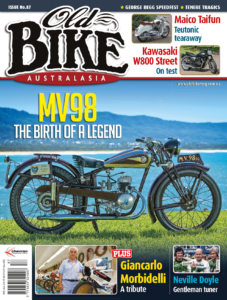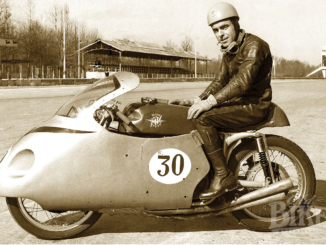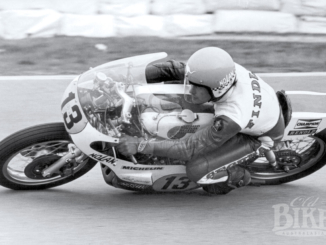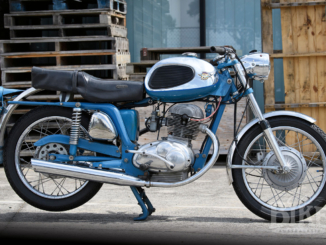
From our Old Bike Archives – Issue 87 – first published in 2020.
Story: Jim Scaysbrook • Photos: Russ Murray and OBA archives.
What sprang from necessity for sheer survival became one of the world’s most iconic motorcycle brands.
Everything has to start somewhere, and in the case of Meccanica Verghera Agusta, it began with the humble 98cc model, christened simply MV98. The path that would lead the world famous company to 37 Motorcycle World Championships for Manufacturers, 38 Riders’ Championships and 270 Grand Prix victories, was forged in war-ravaged Italy in 1943, when things were going from bad to worse.
The wealthy and affluent Sicilian Agusta family had been in the transport business since 1907; not road transport, but air. The first Agusta aircraft, the biplane AG1 glider, was designed by Count Giovanni Agusta in 1907 and made its maiden flight three years later, when it was towed into the air behind a car at Capua Racecourse. The manufacturing centre of Italy was not in the far south however, so Count Agusta moved his family north to the Gallarate district of Lombardy. Funding was needed to develop the concept, particularly for Agusta’s plans to produce his own engine, so he established a business called Construzioni Aeronautiche Giovanni Agusta, overhauling and repairing aircraft at Cascina Costa in Samarate (nowadays home of the MV Agusta Museum) near what is now Malpensa Airport, 50 kilometres north of Milan.
Count Agusta spent the First World War in the Primo Battaglione Aviatori (First Aviation Division), stationed at Malpensa. Soon after peace returned, he set up his first factory in Cascina Costa and purchased the nearby Gaspare Bolla airfield, where he began building aircraft under licence. He also continued with his plans to produce his own complete aircraft, a monoplane, which took until 1927 to achieve. Tragically, Giovanni passed away in the same year, aged just 48, leaving his wife Giuseppina to raise four young sons as well as run the business. Eldest son Domenico inherited his father’s title as well as his commercial acumen, and the business employed around 800 people by the time WW2 broke out.
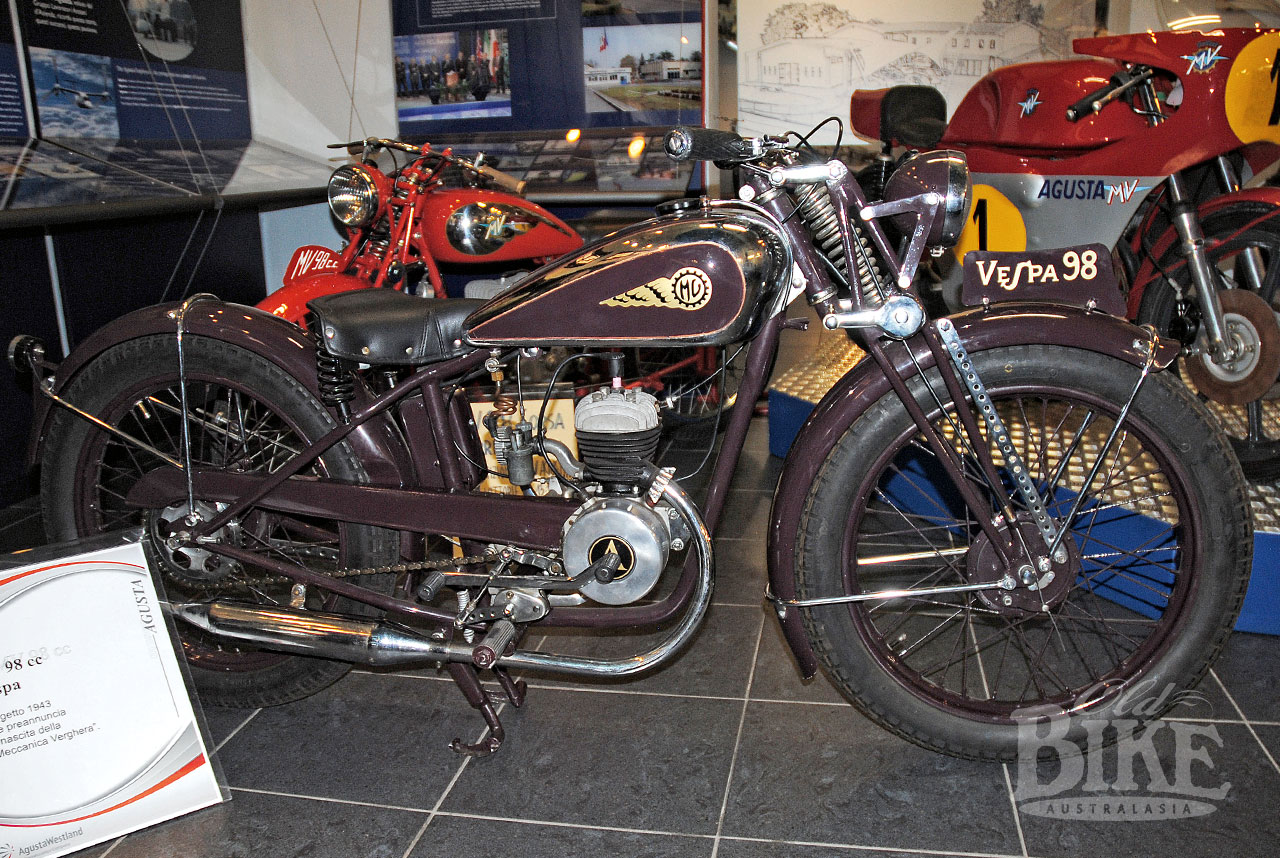
Like all such enterprises, Agusta’s factory was turned over to war production, but by 1943, after the fall of Mussolini, the Germans took control of Cascina Costa, and hence, industries such as that of the Agusta family. It was a brutal period in the country’s history, but Count Agusta could see that the post-war future would be vastly different, and even at this early stage, began planning to diversify from aircraft to other fields – specifically motorcycles. He correctly reasoned that when the war was over, the general populace would have an urgent need for affordable transport; not just the ubiquitous bicycle but something that could cover much greater distances without the physical effort. What was needed, he reckoned, was a motorcycle for the masses.
A change of direction
Agusta’s design was a simple piston-port two stroke, with 49mm x 52mm bore and stroke, vertically-split sand-cast alloy crankcases and a cast iron barrel with cast alloy head. To eliminate the need for a primary chain requiring periodic adjustment, geared primary drive was chosen. The prototype used a 14mm Dell’Orto TA 14A carburettor, a two-speed grease-lubricated gearbox, and initially produced 4hp at 4,800 rpm.
By August 1943 the first engine was virtually complete, and work began on the chassis components. Then on 8th September 1943 the Germans took over the Agusta factory, and all traces of the motorcycle project, including the drawings and patterns, were secreted in the homes of some of the factory’s most trusted personnel. By mid-1944, the military presence in the region has eased slightly, and despite the critical shortage of materials and some components, work recommenced at the factory. Tyres were almost non-existent, as were electrical components, but gradually these were sourced.
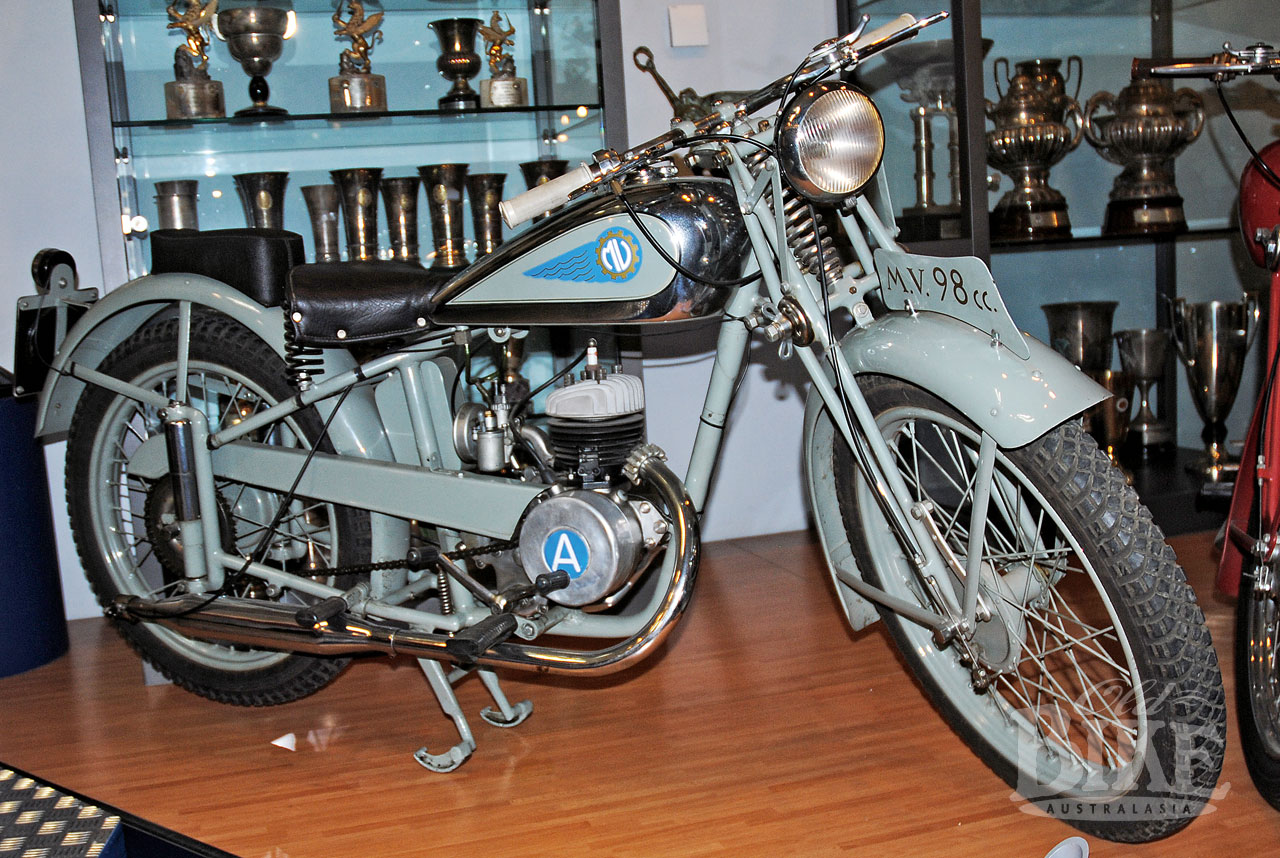
On 19th January, 1945, Meccanica Verghera S.r.l. came into being, specifically to deal with the motorcycle project and to prepare for the process of launching it to the buying public. Soon after the end of the war in Europe on 2nd September 1945, the Italian trade press was running photos and details of the new MV motorcycle. On the petrol tank sat the company’s insignia, with the letters M and V sitting inside a toothed gear with wings. Atop the front mudguard sat a plate with the model name: Vespa (Wasp). What the fledgling MV concern did not know was that the Milan-based Miller-Balsamo company, run by the brothers Ernesto, Edgardo and Mario Balsamo, which had been in the motorcycle business since 1921 with various in-house and bought-in models that included British Rudge (Python) engined models, had registered the Vespa name in 1936 for their 123cc two stroke, ostensibly because the exhaust note was reminiscent of the sound made by a Wasp. Again pre-dating the formation of MV Agusta, the Vespa name and trademark was sold to Piaggio, who commenced legal proceedings to prevent MV from using the name.
This took a little time to take effect, but in the meantime production of what was ultimately called the MV 98 began in October 1945 and on the 24th of that month a complete production model was shown to the press at the dealership in Via Piatta, Milan, in the centre of the city that now lay in ruins. Tyres had been sourced from a very small concern in Cassano Magnago, and flywheel magnetos purloined from various places. A dealer network was obviously a priority, and Egidio Conficoni and Vincenzo Nencioni, two successful motorcycle competitors, were appointed the official representatives for Italy, as well as operating two dealerships, although virtually all of the fifty-odd MV98s built in 1946 were destined for the export market.
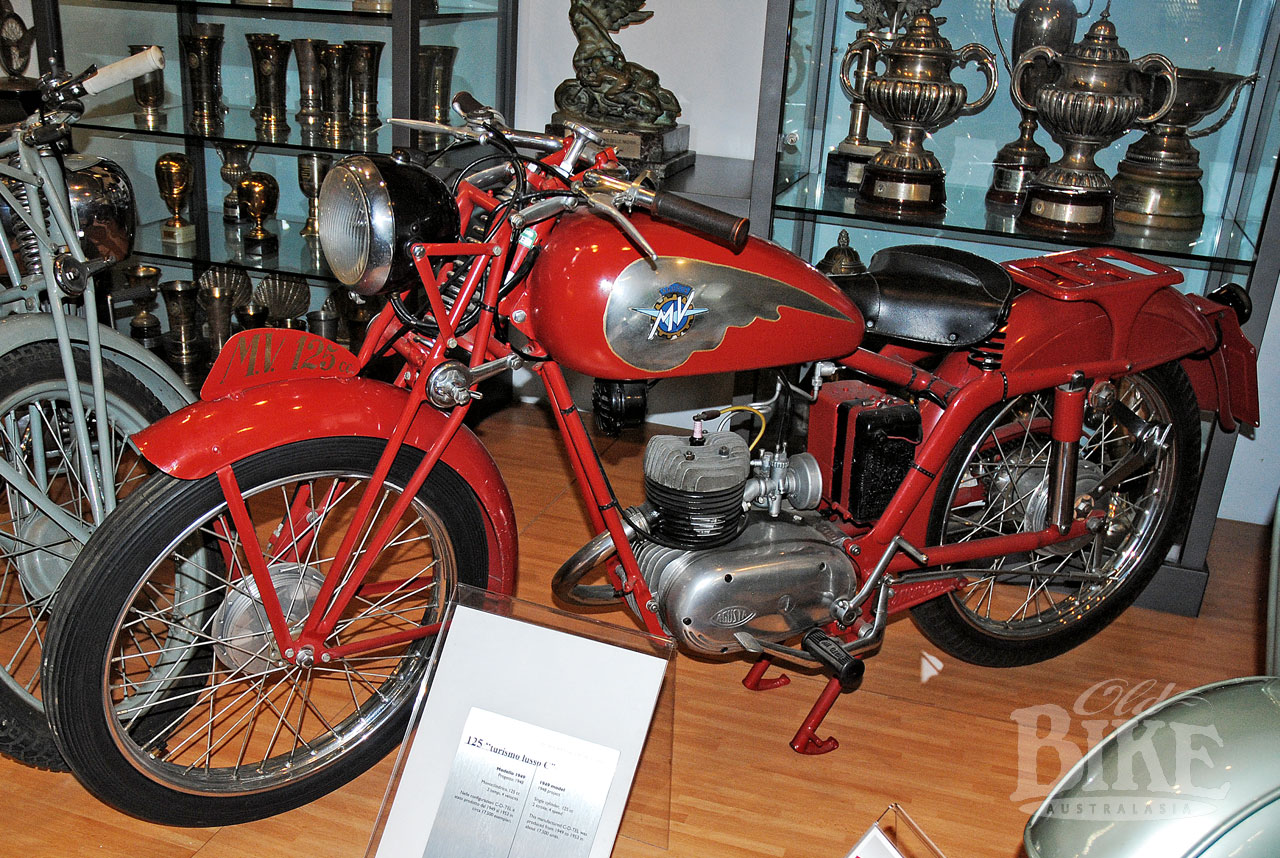
Initially, two versions of the 98 were produced; the standard Economica model, with the prototype’s rigid frame and two-speed gearbox, and the Turismo, with plunger rear suspension and three-speed gearbox. Both sported a full tubular steel frame. A 16mm Dell’Orto carburettor replaced the 14mm of the prototype and bore and stroke were revised slightly to 48mm x 54mm. Girder forks with friction damping provided the front suspension. The specification was hardly the sort of thing to get excited about, but there was no doubting the quality of the engineering. As the new model gained acceptance in the market, the up-spec Turismo proved so popular that the two-speed model was eventually dropped.
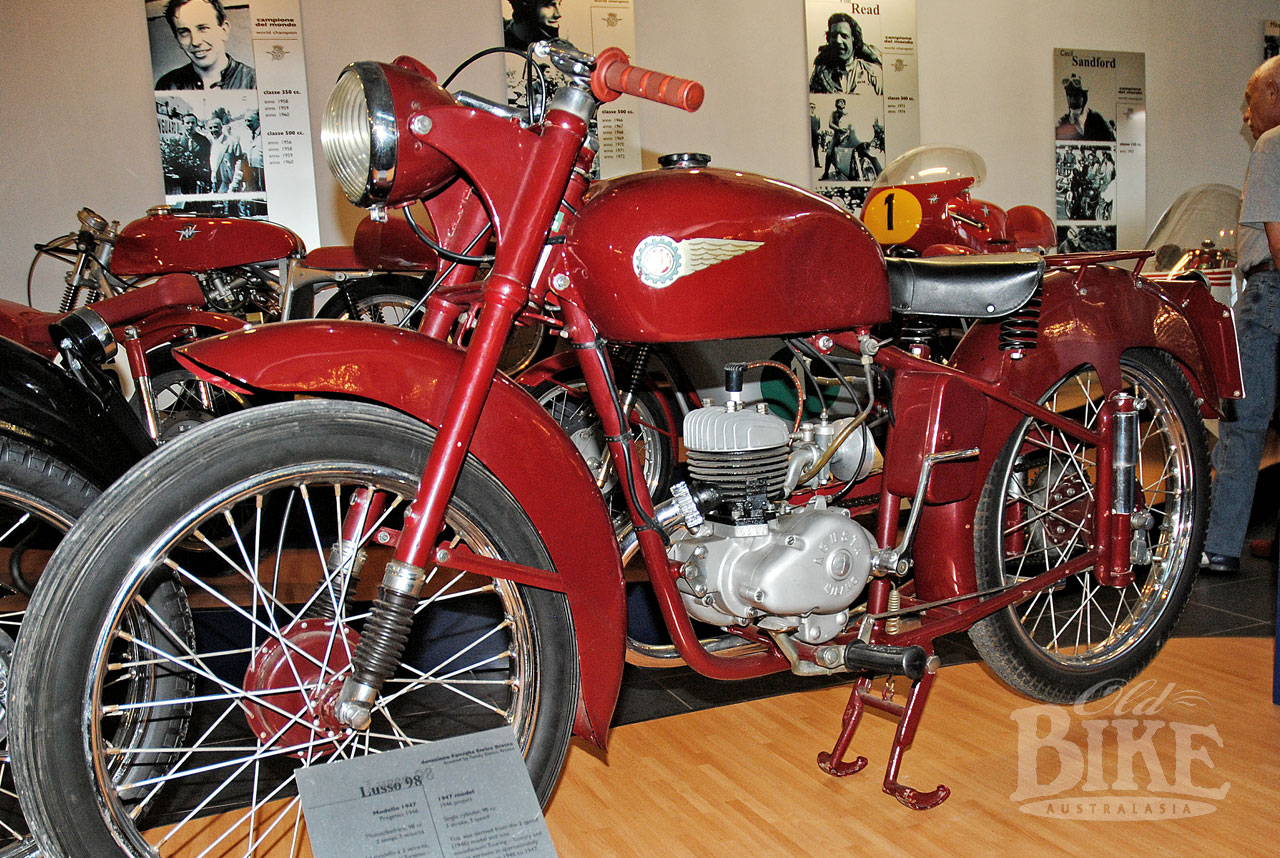
The first of the new 98s delivered to customers actually left the factory still sporting the Vespa name on the plate mounted on top of the front mudguard, but following Piaggio’s legal stance, this was quickly dropped. A third version, the Lusso, appeared for 1947 and was exhibited to great acclaim at the 1947 Milan Show. As motorcycle sport in Italy staggered back to its feet, Count Agusta determined that every avenue in that direction would be pursued in order to publicise the new marque. Even at this early stage, a 125cc version was on the drawing boards as well.
Let’s race
Before the 1946 year was out, several 98s had been stripped and tuned for racing, with immediate success. Vincenzo Nencioni himself won a Speed Trail in La Spezia on 6th October 1946; the beginning of a month-long series of sporting successes. This led to a limited production competition version, the Sport, which appeared later in the same year, featuring a straight through exhaust pipe, a 5cm shorter wheelbase frame, larger capacity fuel tank and telescopic front forks. Weight was reduced with different mudguards and light alloy wheel rims shod with 2.50 x 19” tyres. With a 20mm carburettor fitted, engine power had been increased to 5hp at 5,400 rpm and the three-speed gearbox was used, all of which added up to a top speed of 95km/h.

Also in late 1946, telescopic forks (un-damped) became standard equipment for the two customer models, although girders could still be specified at a cheaper price. The telescopic forks had internal springs and ran in grease-lubricated sintered bronze bushes pressed into the other tubes. The mudguards became slightly more substantial and each model was offered with a parcel rack mounted at the rear. The modifications gave the 98 (now officially referred to as the 98 2T) a more modern appearance and sales continued their upward climb as a result. For whatever reason, outright performance dropped a little, to 2.7hp (possibly due to the deteriorating quality of the fuel available), with a slightly lower compression ratio of 5.6:1, but the three-speed gearbox, with ratios of 19.5:1, 11.5:1, and 8.o:1 made quite a difference in acceleration.
With the original rigid frame now discarded, production consisted of the Normale, with girder forks, the Lusso with telescopic forks and the racing Sport model. As 1946 drew to a close, the factory at Cascina Costa was now building an incredible thirty units per day, which was quite an achievement given the state of the nation and the shortage of materials. By 1947 the engine adopted a cross-flow scavenging system with a flat-topped piston to replace the original design with its deflector-crown piston with two ports.
For 1948, the 125cc class became a fixture in the Italian Championships, and would also form an official class for the F.I.M. World Championships to be introduced in 1949. Naturally, MV quickly set about readying themselves with a 125 of their own. These appeared in late 1947 in road trim, with a four-speed gearbox and gear primary drive. Engine dimensions were 53mm x 56mm bore and stroke to give 124cc. Power was 5hp – the same as the racing 98 – and a top speed of 85 km/h claimed. Swinging arm rear suspension was used, with a girder front fork, which was odd because the later 98cc models had by then adopted telescopic forks. A special racing version was ready for the start of the 1948 season. Towards the end of that year, MV won its class at the Italian Grand Prix at Faenza, giving the company its first racing win in top level competition.
Buoyed by the success, MV announced it would participate in the World Championship of 1949 in the 125cc class. By this time, the company was back in business building aircraft; monoplanes at first and later Bell Helicopters made under licence, so there were ample funds available to go racing in the new series. However the two stroke MV was no match for the twin overhead camshaft Mondials, and MV abandoned two strokes for their racing effort thereafter.
The two stroke road machines, with their inherent simplicity, ease of maintenance and low running costs, continued in the MV Agusta range for a number of years, but production of the 98, which had begun the whole process, ceased by 1948. Around 1,700 were made in the three versions, not including the racing models. Several examples of the 98 (and the later 125s) exist in the MV Agusta Museum in Cascina Costa, and one of these is described on the show card as a ‘Projetto 1943’ (Project 1943) which signifies that the original drawings came from that year when the Milan area was under Nazi occupation. The motorcycle shown has a rigid rear end frame, girder front forks, and a different shaped cylinder head, but otherwise resembles the 1945 version. It also has the moniker ‘Vespa’ denoting that this was prior to the name being dropped. Also displayed is a 98 Corsa with an outsized cylinder head, which the accompanying placard says claimed 44 victories between October 1946 and March 1948, when the racing 125 came on stream.
Thus from humble beginnings (you don’t get much more humble than a 98cc 2-speed two stroke), MV Agusta rose to become the most successful marque in Grand Prix racing; an iconic brand that continues to this day, albeit under different ownership. It is fortunate that the company was steered by a dedicated band of engineers, designers and managers, even if under somewhat autocratic rule. And I for one am not disappointed it wasn’t called Vespa.
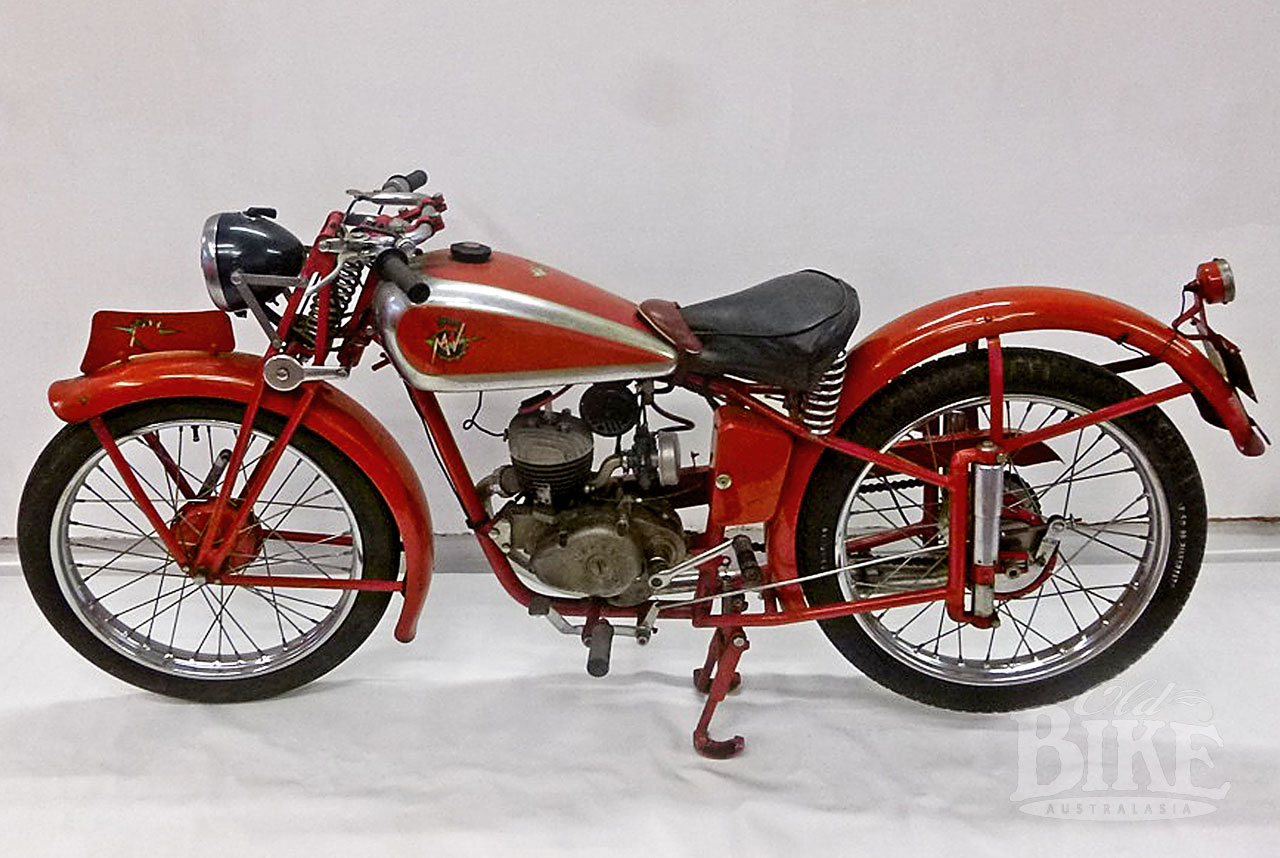

A local lovely
From the total production run of 98s that amounted to around 1,700 units, few have survived, and are especially rare in our part of the world. In fact there is little knowledge of the model as most recognition of the MV Agusta marque (at least outside Italy) came about as a result of the successes of the works-backed racing team and the replica 125cc Overhead Camshaft models that were available to customers who could afford them.
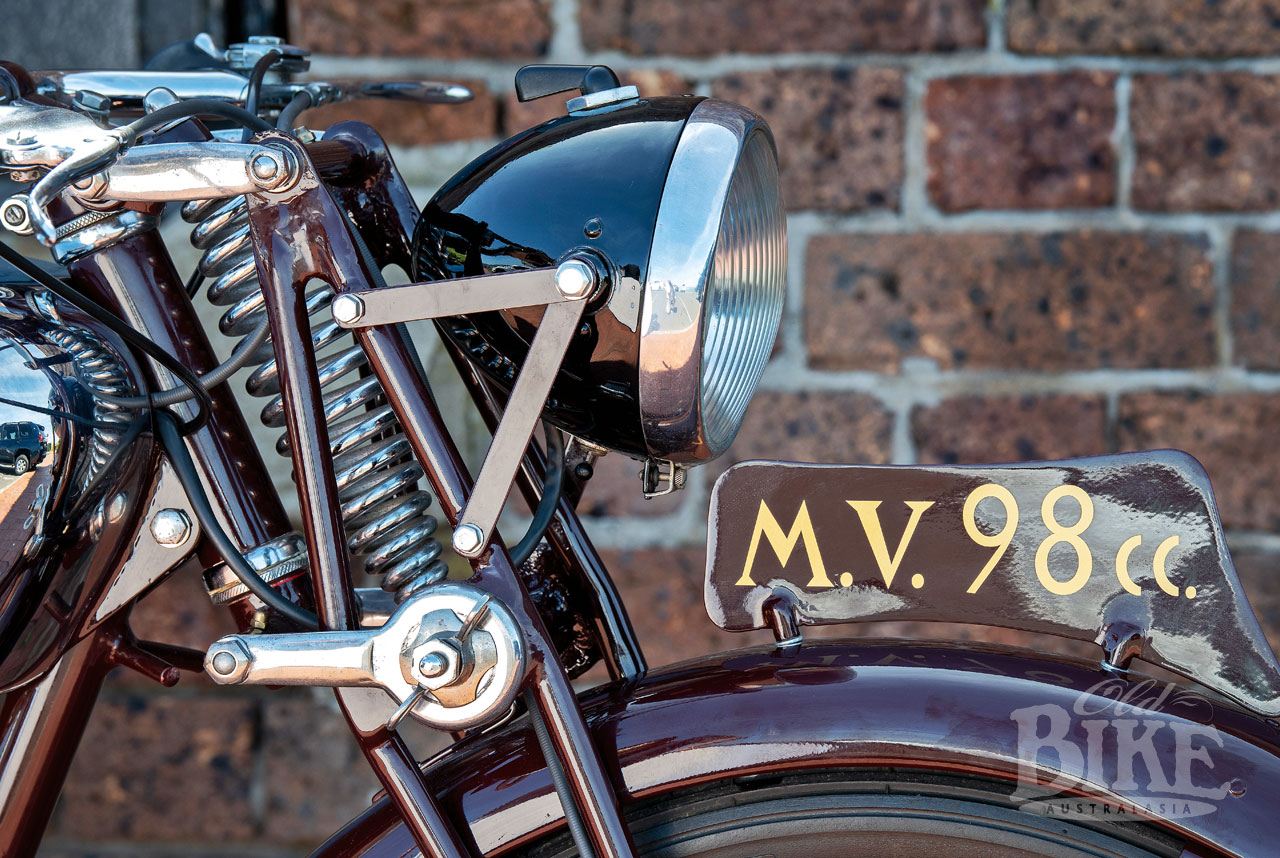
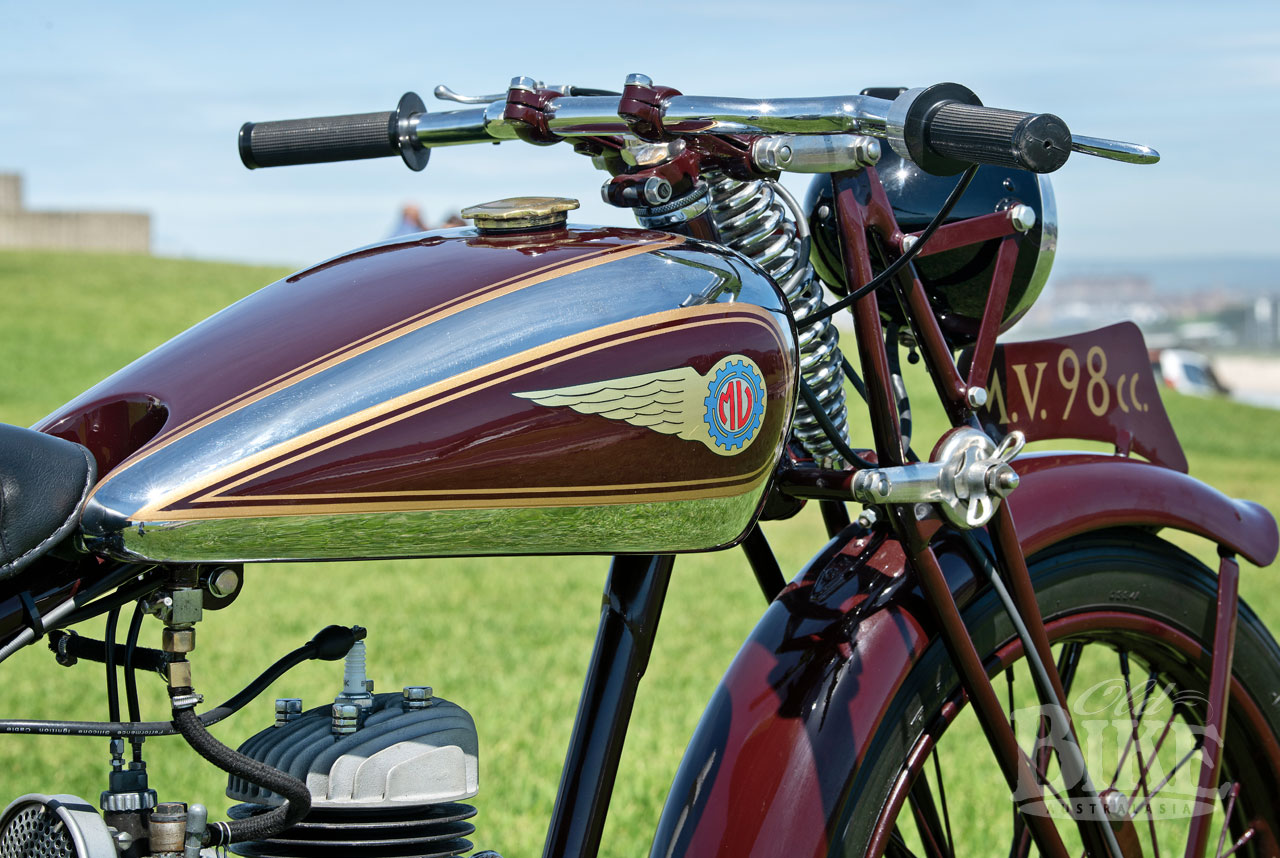

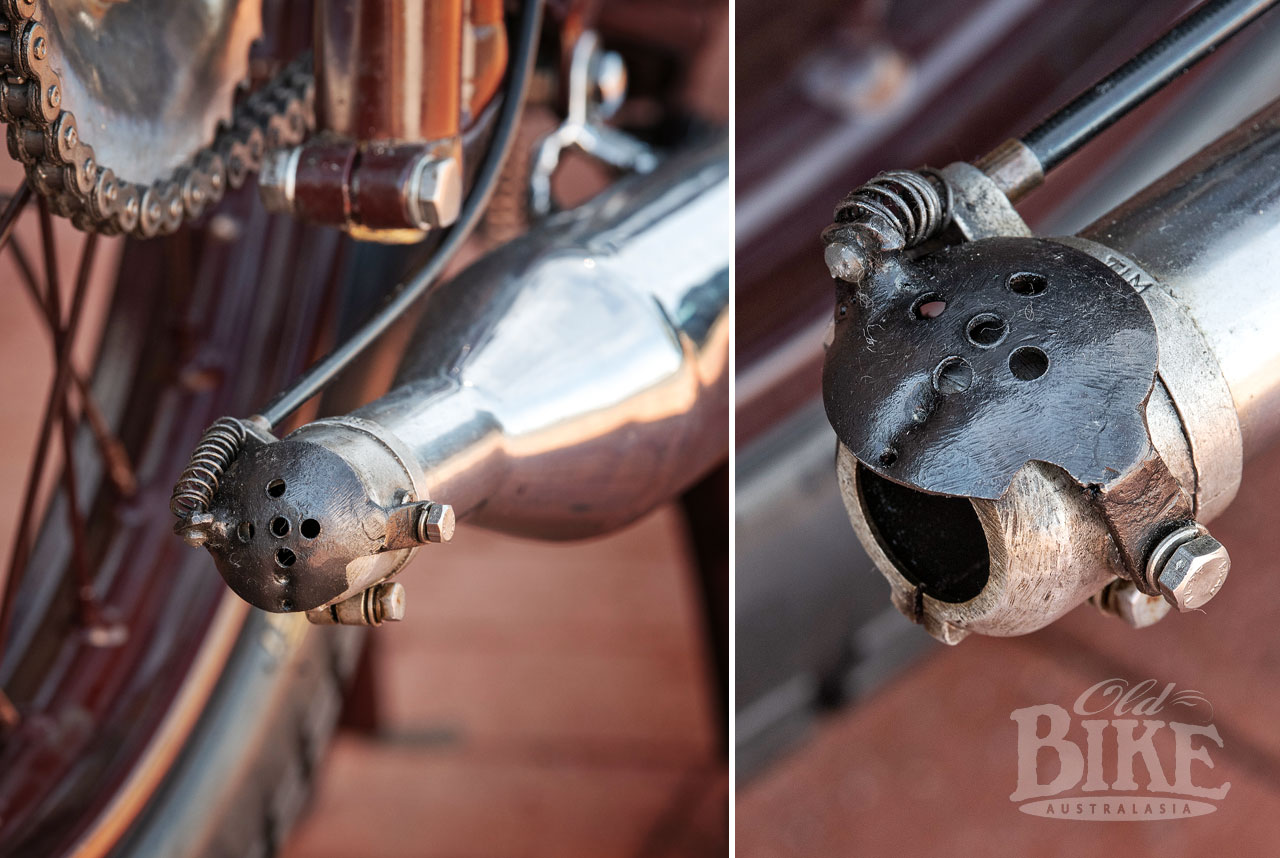
It had been fully restored right down to having a piston manufactured for it, which held up the project for four months while the piston was being specially made. It has new clutch plates and refaced brake shoes. The carby remains in original condition exterior and has deliberately not been touched, which makes it look a little out of place on the otherwise (now) perfectly restored bike, but I like the link.
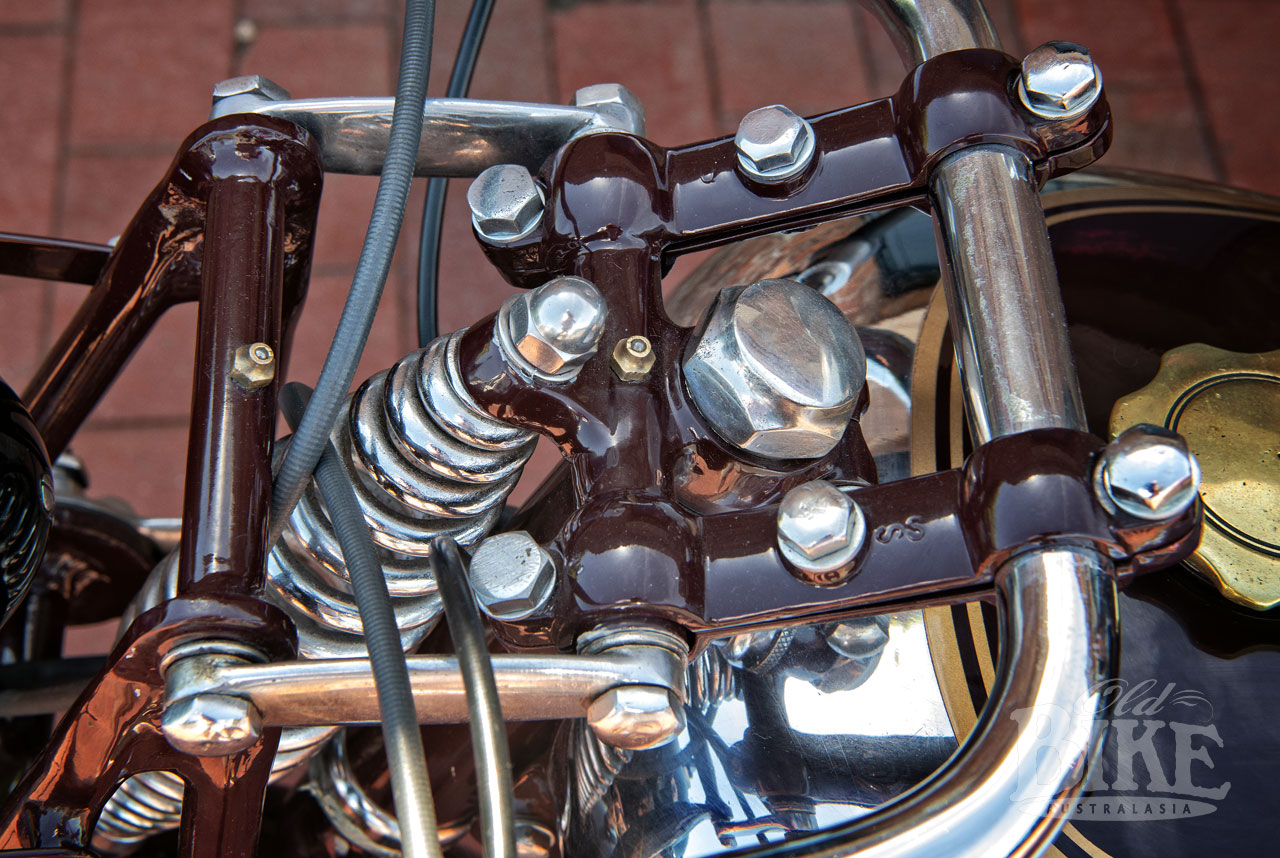
It is a very reliable runner, from cold it starts easily, albeit on the motorised starter from my race bikes, I don’t like to stress the old metals by putting pressure on the starting mechanisms. Once it’s warm, you can use your hand to turn over the kick starter and make it run! It took me 20 years to find the 98 but I regard it as an integral part of my collection.


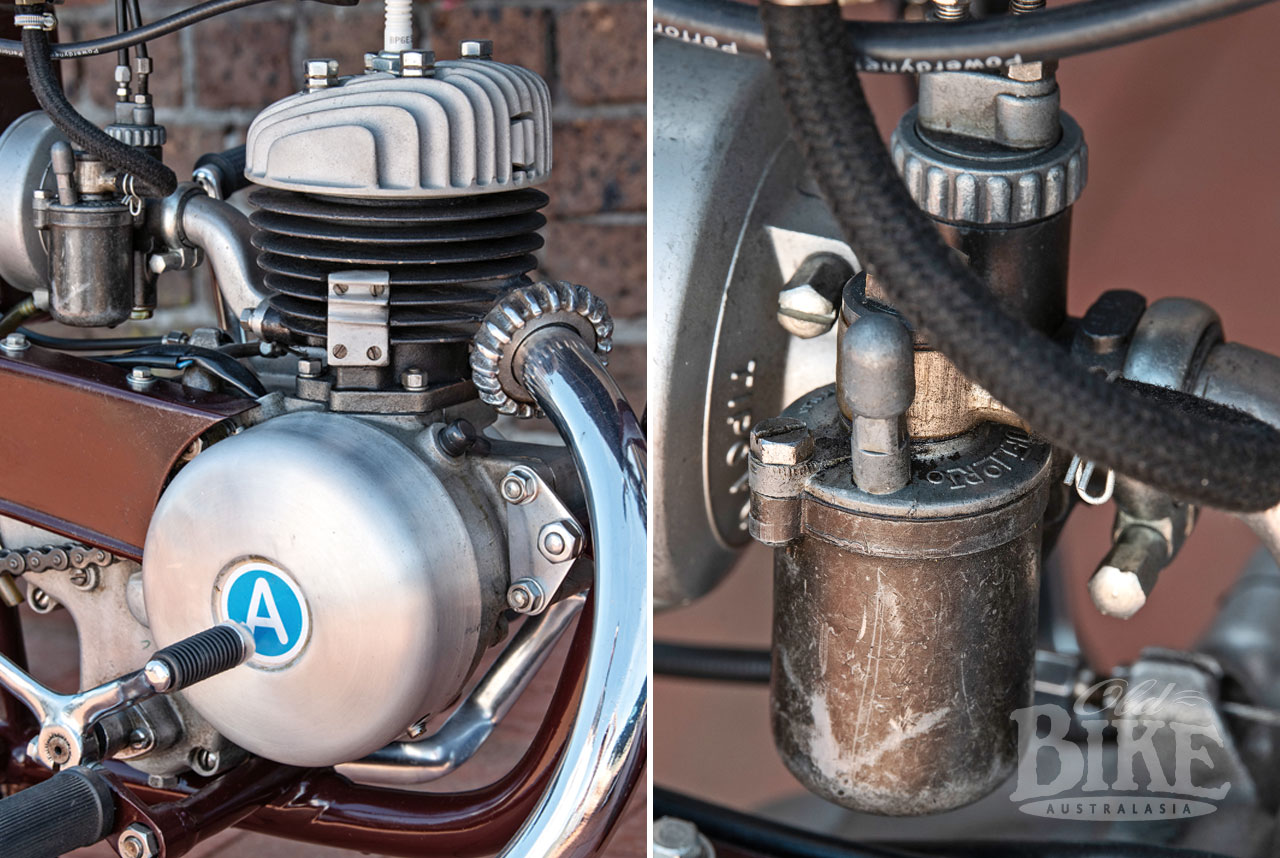

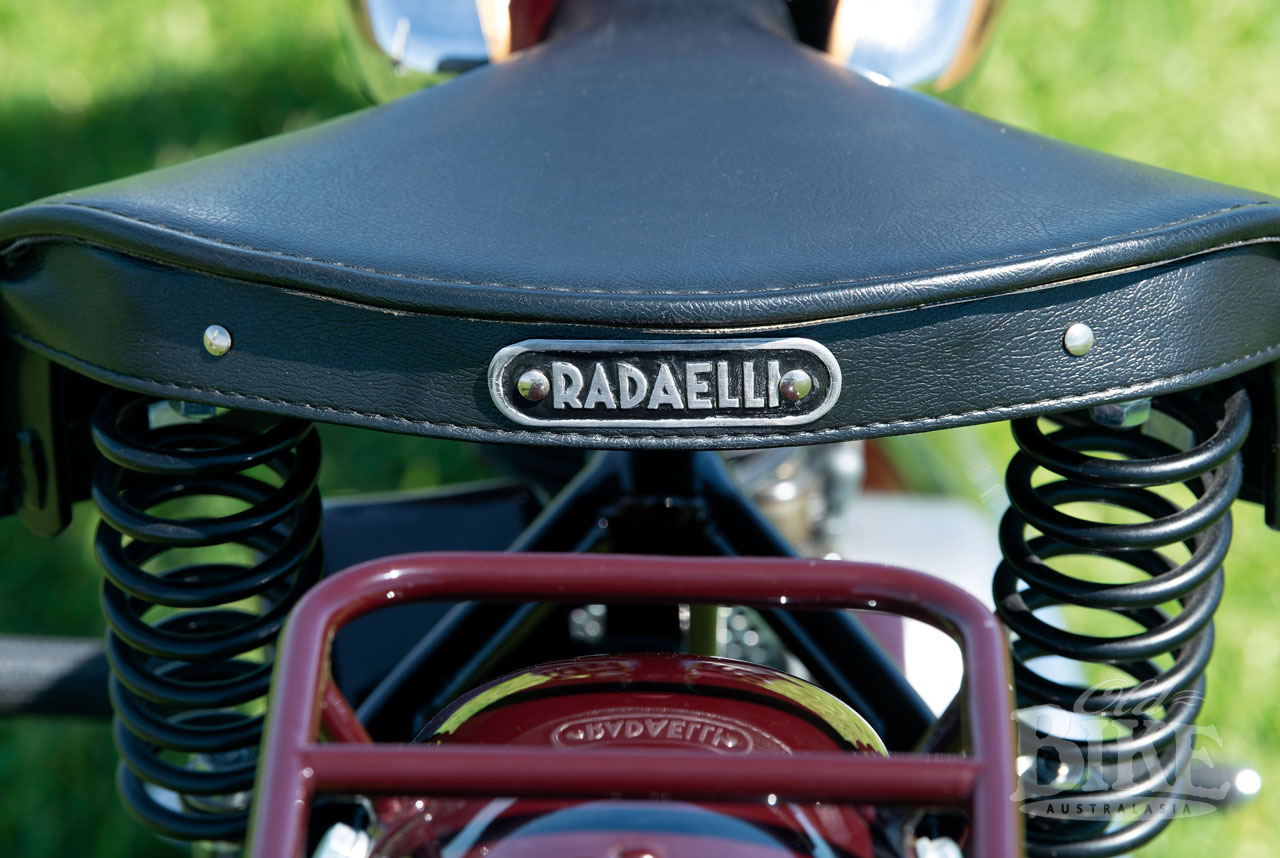
Specifications: 1946 MV98 Turismo
Bore x stroke: 48mm x 54mm
CR: 6.0:1
Power: 3.5hp at 4,800 rpm
Carb: Dell’Orto TA 16A
Lubrication: Petrol/oil mix 20:1
Transmission: Primary: Straight cut gear. Rear: Chain
Gearbox: 2 or 3 speed, wet clutch
Frame: Tubular steel
Suspension: Front: Girder fork, Rear: Plunger spring units
Brakes: 125mm front and rear
Weight: 70kg
Fuel capacity: 9.1 litres
Tyres: Front: 2.50 x 19 Rear: 2.75 x 19
Wheelbase: 1250mm
Top speed: 70 km/h
